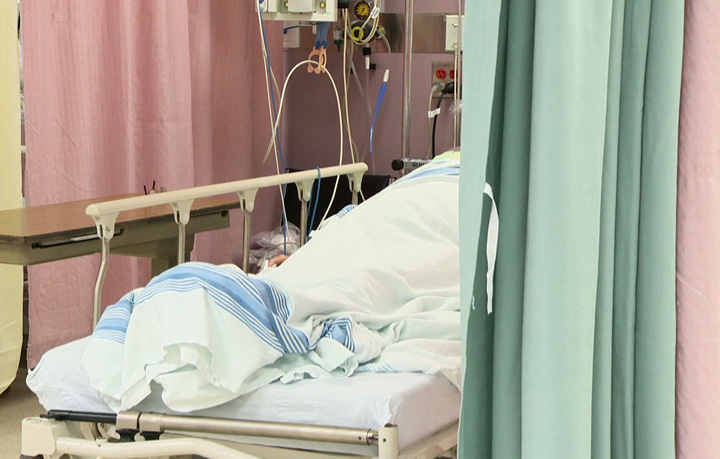TORONTO – Canadians with cystic fibrosis who have a lung transplant get a definite boost in survival, with half of those who receive the new organs living at least 10 years following the surgery, researchers have found.

Their study, the first to use the Canadian Cystic Fibrosis Registry to analyze post-transplant survival rates between 1988 and 2012, found 88 per cent of patients were alive after one year and 67 per cent had survived by the five-year mark.
“People think when you have cystic fibrosis and need a transplant, it’s a death sentence,” said lead author Dr. Anne Stephenson, a respirologist at St. Michael’s Hospital in Toronto who specializes in treating CF. “But our paper shows that one-, three- and five-year survival rates following lung transplantation are really quite high.”
“It may actually prolong your life and prolong your life substantially,” Stephenson said Monday.
READ MORE: Canada marks 30th anniversary of first successful lung transplant in the world
The study of 580 patients, which involved co-authors in Toronto, Ottawa and Montreal, was published Monday in the Journal of Heart Lung Transplantation.
Cystic fibrosis is an inherited disease that affects the lungs and digestive system. It causes the body to produce thick, sticky mucus that clogs the lungs and leads to life-threatening lung infections. An estimated one in every 3,600 children born in Canada has cystic fibrosis.
- This H3N2 flu strain is spreading ‘rapidly.’ Why subclade K is hitting hard
- U.S. may soon reclassify marijuana to allow medical research. What to know
- EU proposal would ease cross-border abortion access for women facing bans
- Ontario influenza ICU admissions up 127% in past week, hospital association warns
“They spend their whole lives coughing, bringing up mucus,” she said.
The disorder also damages the pancreas, preventing the production of enzymes needed to digest food and to absorb nutrients, so CF patients must take handfuls of pills containing digestive enzymes every day.

Get weekly health news
READ MORE: Lungs don’t die when you do, so study seeks donors who die outside of the hospital
Patients also spend a good part of each day with strict treatment regimens, including having chest physiotherapy and taking inhaled antibiotics.
“They could spend literally, when they’re (relatively) well, three hours a day doing therapy to maintain their health,” Stephenson said. “And as, of course, their lungs deteriorate, that number goes up and they spend the majority of their day doing that.”
Over time, frequent respiratory infections create scarring in the lungs, leading to a severely diminished capacity to breathe.
“You can’t live if you can’t breathe,” she said, noting that it is these chronic, often antibiotic-resistant lung infections that are the most common cause of death in CF patients.
While having a double-lung transplant cannot cure cystic fibrosis, as the defective gene remains in the body — only the donor lungs don’t contain the mutated gene — the surgery can certainly alter the prognosis in many patients, Stephenson said.
“So when they get the new lungs, the incredible thing is that they no longer produce sputum (mucus), they no longer cough, they no longer have to do chest physio, they don’t have to take inhaled antibiotics.
“Not to mention that they can now breathe. They can jog, they can travel — all the things that (most people) take for granted.”
That was the case for Hattie Dunstan of Toronto, 27, who had a lung transplant five years ago.
READ MORE: Rare transplant allows U.S. man to eat again, just in time for Thanksgiving
Repeated lung infections had meant a revolving door of hospital admissions to receive intravenous antibiotics. Despite the treatment, her ability to breathe was steadily declining — as was her energy.
“Showering was exhausting. I couldn’t pick up my cat’s water dish to feed her,” she said. “I’m 22, all my friends are going out dancing and living their lives and I can’t even complete university.
“I had lung envy — I couldn’t do anything.”
Doctors put her on the waiting list for lungs from a deceased donor. Her status was bumped up to top priority when it was determined she might not live out the week, and as luck would have it, donor lungs that were a match for her tissue became available.
While Dunstan had a difficult time with recovery following the transplant, she said the difference it has made in her life is “amazing.”
“I play sports, I travel, I walk my dog, I run my own business,” she said of her online bridal jewelry store, called Hattitude. “I’ve been able to do everything, and beyond my wildest dreams.”
READ MORE: Personalized cancer care: Treating the ‘new face’ of lung cancer in Canada
Seeing the survival statistics in the St. Michael’s study is comforting.
“I really like it because I’m at five years, so I love seeing 10 years. I know so many people who are 18, 20, 25 years out (post-transplant),” she said.
“Anything is better than the few months I probably would have got with my old lungs.”
Patients who have donor organ transplants of any kind must take life-long drugs to prevent rejection, but their suppression of the immune system makes it harder to fight off infections, which remain a threat even to the new lungs. In some people, immunosuppression medications still don’t prevent the body rejecting the donor organs.
Stephenson said of the 580 patients in the study, 232 died, most from infection, but some from chronic organ rejection.







Comments